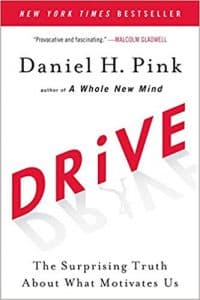I bet you have heard about extrinsic motivation all the time. But what exactly is extrinsic motivation and how do you get extrinsically motivated? This is what you’re going to discover in this guide…
What is Extrinsic Motivation?
Extrinsic motivation is the stimulation of behavior through external factors. In simple terms, it is a reward-driven behavior.
Meaning, you get motivated because of external factors.
Consider reading this article right now. Think about why are you reading it. Do you read it because you want to understand the subject so that you can get a good grade in your psychology class?
Or you read this article because you are passionate about this subject and are curious to learn more about it?
If you are reading this article because you want to score good grades or because you are doing research for this topic, then, you are extrinsically motivated.
- You’re motivated to read due to an external cause – you want to score good grades for your homework.
On the other hand, if you are reading this article because you are curious to learn more and you simply love the topic of motivation, then, you are intrinsically motivated.
- You’re motivated to read because you love this topic and you’re curious to learn more – the drive comes internally.
Can you see the difference now? When you are driven by an external factor to do something, it is said that you’re extrinsically motivated.
And to understand both extrinsic and intrinsic motivation better, I suggest you read this article below:
What is Intrinsic and Extrinsic Motivation and How to Get More of Them
Examples of Extrinsic Motivation
If you are still unclear about how this form of motivation works, allow me to give you a few more examples here…
Consider this: You hate your job, but you work for it because of the pay. You don’t like your work and you hate going to the office. The only reason you still hold on to the job is that you have got bills to pay and you need money to put food on the table.
This means that money, the reward, is the external factor that you are pursuing. You work because you want to be financially rewarded. The reward (salary) is the extrinsic motivation that drives you.
Another example: You want to get your kids to do their homework or study, how will you do it?
For most people, they will offer their kids a reward like a treat or a toy if they study or do the homework, right? That’s extrinsic motivation.
You are using the toy as an external reward to drive your kids into doing the homework.
Now, there is nothing right or wrong with external motivations. In fact, external motivations are important because they help us achieve greater success in life.
Extrinsic motivation pushes us higher and to live a better life. We strive to want to earn more, to have a better lifestyle, and to live comfortably, mostly because of extrinsic motivation.
Think about it, if there is a choice, I don’t think you’ll want to live in poverty, right?
And this is how extrinsic motivation plays an important part in our lives. We strive to achieve something better because of the external rewards we desire.
Below are some of the external rewards that we commonly pursue:
- We train and work hard to compete in sports for trophies and prizes.
- We buy things to satisfy our desire and need.
- Most sales jobs are extrinsically rewarded with commissions.
- When you buy something because of discounts or buy-one-get-one-free promotions, that’s an extrinsic drive to trigger your buying behavior!
If you want to further understand what truly motivates you in life, check out one of my top articles:
What Motivates You In Life? The 6 Common Factors That Drive People
The Benefits of Extrinsic Motivation
Now that you understand what is extrinsic motivation, so what are the benefits of it? And how can you use it to affect your life and help you in achieving your goals?
Well, I believe extrinsic motivation plays a huge part in our daily life. No matter what we want to achieve, we can use external forces to boost our drive and help us reach our objectives.
For instance, if you want to lose the additional fat on your body, but you lack the motivation to do so, you can then use some external factors to help increase your motivation for exercise.
You can reward yourself with a movie after your exercise session, or you can reward yourself with a holiday if you hit your weight loss target.
That’s how you can make use of external motivations to boost your drive and get things done.
However, the use of the right “treats” and the timing need to be precise. You certainly don’t want to reward yourself with a bowl of chocolate ice-cream for exercise. And you want to reward yourself immediately after the behavior.
Think about how trainers train animals. Once the dolphins perform the act that the trainer requested, the trainer will reward the dolphins immediately.
How you use rewards can greatly impact your external motivation.
Read: Why It Is Important to Reward Yourself for Your Hard Work
In my opinion, extrinsic motivation can be very powerful. If used correctly, it can help you achieve any goal you desire.
This is how people achieve most of their goals and become successful. You can set an exciting goal, create a plan, make progress, and reward yourself correctly to help maintain your motivation throughout the journey.
Hence, learn how to reward yourself the right way. Choose the right reward and you’ll be motivated to achieve. Choose the wrong reward and you’ll procrastinate. Check out this guide.
The Disadvantages of Extrinsic Motivation
Yes, extrinsic motivation can be powerful when applying correctly, but there are also disadvantages to it.
The first and the most common downside of the external drive is that it usually won’t last.
Imagine you have just downloaded a new game on your phone. You’re excited about the game because it is new and there are many surprises that spark your motivation.
But after playing the game for a few days or weeks, your motivation started to wane. You don’t feel excited about the game anymore like when you first played it.
Eventually, you stop playing the game and start looking for other games to play. Does this sound familiar?
This is one of the downside of extrinsic motivation. It usually will not last.
You will have to keep looking for new and more exciting rewards to keep your motivation going.
Here’s another good example: If I give you $100, you feel great.
But if continue to do so every week, eventually, you won’t be as thrilled as when you first received the $100 from me. It becomes a norm and you already expected it from me.
Eventually, your drive slowly goes down and you don’t feel as motivated as before.
But if I make some changes, like instead of giving you $100, I give you $300, you will become excited about it again.
So, to sustain extrinsic motivation, you need the “surprise” factor. You need to look for ways to be creative in rewarding yourself.
There are both advantages and disadvantages to extrinsic motivation, just like how this article points out. It all depends on how you develop it.
How Effective is Extrinsic Motivation
This is a subjective question. It depends on the person and his or her personality and preferences.
For some people, they are motivated toward playing games, while for some, they prefer to watch movies than playing games.
The kind of reward also plays an important role in determining the effectiveness of extrinsic motivation.
I’m someone who loves to read. To me, reading business and personal development books is a form of a reward of itself. But for some people, they don’t like to read. They prefer to watch an educational video or listen to a podcast.
In a famous experiment by Lepper, Greene, and Nisbett, children were lavishly rewarded for drawing with felt-tip pens. Here’s what the research has discovered:
When the children were later offered the chance to play with the pens during playtime, the children who had been rewarded for using them previously showed little interest in playing with the pens again. The kids who had not been rewarded, however, continued to play with the pens.
The same reward to spark extrinsic motivation can lose its effectiveness if it is used incorrectly, or excessively.
How to Develop Extrinsic Motivation to Drive You For Greater Success
Learning how to master your extrinsic motivation is important.
If there is a goal you want to achieve but you often find it difficult to get the motivation to work for the goal, there are only 2 ways to work around it:
- Develop intrinsic motivation, or
- Develop extrinsic motivation.
In this article, our focus is on extrinsic motivation. But if you want to learn more about getting intrinsically motivated, read this guide below:
What is Intrinsic Motivation and How to Get Intrinsically Motivated
So let’s get back to extrinsic motivation. Here are 4 effective ways how you can boost your external motivation to become more productive…
1. Set Exciting and Empowering Goals
First, make good use of this powerful technique – goal setting. When you set goals, you are giving yourself the result you want and you can then make a plan to achieve it. You identified your target through setting goals.
More importantly, your goals can work as an external reward that can make you more successful in life.
Goal setting gives you a clear idea about what kind of result you are seeking and what you need to do to get the result. Plus, it helps you identified your milestones and actionable steps where you can act on.
And with specific action steps, you can then reward yourself for your hard work.
Do you want to learn how to set powerful goals and achieve the success you desire in life? Follow my technique here: Goal Setting Formula.
2. Reward Your Effort
Choose the right reward for your progress. Remember, you want to reward yourself for your effort. Thus, regardless of whether you succeed or fail at hitting your target, you should reward yourself.
You want to make execution your habit. So, reward your effort.
For example, you should reward yourself after every exercise session. Although you didn’t immediately lose the fat, you still reward yourself for your effort.
And choose the right reward as what we have talked about above. If you need more ideas, read this article below:
How to Reward Yourself for Your Hard Work and Effort
3. Celebrate Your Victories
Yes, celebrate your victories no matter how big or small. Just like how you reward for your effort, you should learn to celebrate your wins to transform your extrinsic motivation to intrinsic.
Every time you completed a task, you should celebrate. Give a pat on your back. Jump and shout yes. Do a fist pump. Feel good about it.
You want to train your brain to feel good about making progress. The more you celebrate your wins, the more wins you will get to celebrate.
You want to boost your momentum by feeling good that you have accomplished something. The more momentum you get, the more you can achieve. And the more you achieve, the more momentum you get. It’s a cycle.
Learn how to celebrate your success:
13 Great Ways How to Celebrate Small Victories and Make Progress
4. Get the Accountability You Need
Another way to increase your extrinsic motivation is to raise your level of commitment. You can find a social support partner or friends and family to hold yourself accountable for achieving your goals.
When you have an accountability partner to monitor your progress, you will become more committed because your reputation is at stake.
Imagine you tell your friends you are going to buy your dream car in the new year, notice how your commitment changes.
Almost instantly, you can feel the pressure. You are accountable for what you say and your actions. Therefore, when you get the accountability you need, you greatly increase the external motivation to boost you to the next level.
So, get yourself an accountability partner. Build your commitment, up the game, and get someone to give you the “eustress” (positive stress) to achieve your goals.
Additional learning:
- 7 Easy Ways How to Hold Yourself Accountable for Your Goals
- 10 Powerful Steps How to Fully Commit to Goals That Terrify You
Additional Resource on Internal and External Motivations
The best part about extrinsic motivation is that we can “manufacture” it. Unlike intrinsic motivation that is more difficult to produce, we can easily use an external reward to increase our motivation to take action.
If you find that you lack the motivation to achieve something in life, you can work out on finding the right external reward to boost your drive.
Here’s a great book about external and internal motivation you should read:

Conclusion
Extrinsic motivation has its good and bad. It can be powerful if you apply it correctly.
There is nothing wrong with extrinsic motivation. As long as you understand how it works, you can use it as a powerful tool to help you achieve what you want in life.
So, do you read this article because you need to complete a task or your research? Or do you read this article because you love this subject?
Do share your comments about this article below. Let me know what you think. Cheers.


